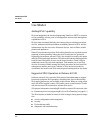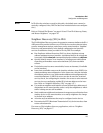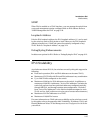
2-8
Introduction to IPv6
Configuration and Management
and the interface identifier currently in use in the link-local address. Having a
global unicast address and a connection to an IPv6- aware router enables IPv6
traffic on a VLAN to be routed to other VLANs supporting IPv6-aware devices.
(Using software release K.13.01, an external, IPv6- aware router is required to
forward traffic between VLANs.)
Multiple, global unicast addresses can be configured on a VLAN that receives
RAs specifying different prefixes.
DHCPv6 (Stateful) Address Configuration
The IPv6 counterpart to DHCP client for IPv4 operation is DHCPv6. Global
unicast addresses of any scope can be assigned, along with NTP (timep) server
addressing when DHCPv6 server support is available through either of the
following modes:
■ accessible on a VLAN configured on the switch
■ accessible through a connection to a router configured with DHCP relay
IPv6 also allows the option of using stateless autoconfiguration or static
configuration to assign unicast addresses to a VLAN, while using a DHCPv6
server for time server addressing.
Static Address Configuration
Statically configuring IPv6 addresses provides flexibility and control over the
actual address values used on an interface. Also, if a statically configured link-
local address is configured on a static VLAN, the global addresses configured
on the VLAN as the result of router advertisements uses the device identifier
included in the link-local address. Statically configuring an IPv6 address on a
VLAN enables IPv6 on the VLAN if it has not already been enabled.
Default IPv6 Gateway
Instead of using static or DHCPv6 configuration, a default IPv6 gateway for
an interface (VLAN) is determined from the default router list of reachable or
probably reachable routers the switch detects from periodic multicast router
advertisements (RAs) received on the interface. For a given interface, there
can be multiple default gateways, with different nodes on the link using
different gateways. If the switch does not detect any IPv6 routers that are
reachable from a given interface, it assumes (for that interface) that it can
reach only the other devices connected to the interface.


















